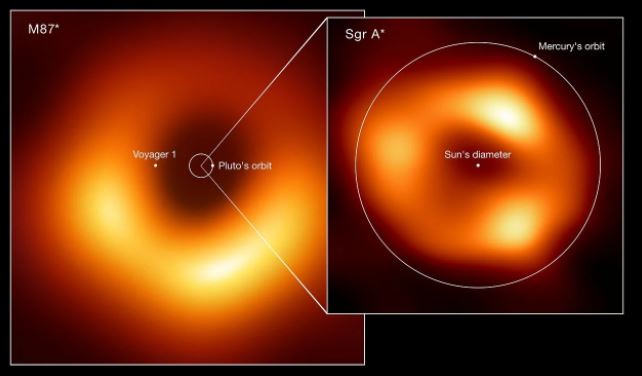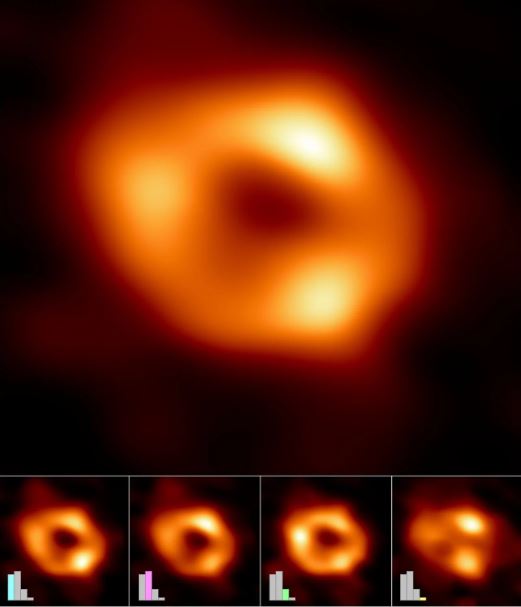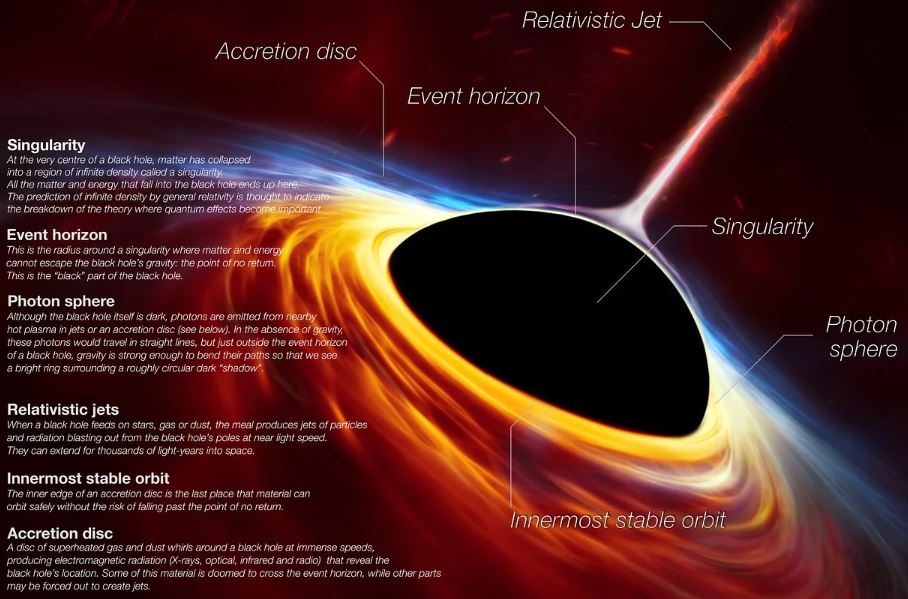Play below for the audible version of this article:
Four and a half billion years ago, our pale blue dot was born in the rubble left over from the birth of a star. Since then, we’ve been locked in a cosmic dance; Earth whirls around the Sun; and the Sun whirls around the galactic center – the dark, mysterious heart of the Milky Way.
Contained in that dark heart, around which the entire galaxy revolves, is a supermassive black hole named Sagittarius A*, clocking in at roughly 4.3 million times the mass of the Sun. We’ve been able to infer its presence, and measure it, based on the movements of objects around it, but never had we seen the object itself.
That image at the top of the screen – looking like a glorious blurry orange donut – is the dust around and shadow of Sgr A* itself, seen by humanity for the very first time, thanks to the hard work of the Event Horizon Telescope collaboration.
“We were stunned by how well the size of the ring agreed with predictions from Einstein’s Theory of General Relativity,” said EHT Project Scientist Geoffrey Bower of Academia Sinica in Taipei.
“These unprecedented observations have greatly improved our understanding of what happens at the very center of our galaxy, and offer new insights on how these giant black holes interact with their surroundings.”
The achievement comes three years after the collaboration released the first image of a black hole’s shadow ever obtained – a supermassive black hole named M87*, clocking in at 6.5 billion times the mass of the Sun, at the center of a galaxy 55 million light-years away.
Sgr A* is considerably closer to us, at a distance of around 25,800 light-years. But the two black holes presented very different challenges.

Attempting to image a black hole is attempting to image the invisible. Black holes give off no radiation we can detect. They’re so dense that, past a certain point known as the event horizon, not even light, the fastest thing in the Universe, is able to achieve escape velocity from their gravitational pull.
M87* is what we refer to as an active galactic nucleus. That means it’s feeding – surrounded by an enormous disk of dust and gas that is getting pulled into the black hole. The insane friction and gravity involved heats this material so that it glows brightly. That’s what we see in the picture of M87*, with the shadow of the black hole in the center of the glowing material. Sagittarius A* may be closer… but it’s nowhere near as active. In fact, if Sgr A* were a person, it would only consume the equivalent of a grain of rice every million years.
Moreover, the Milky Way galactic center is thick with dust that obscures much of what is contained therein.
Scientists had previously detected a cloud of gas orbiting Sgr A*, an accretion disk of the black hole’s very own, but it’s relatively cool and glowing much more faintly. Moreover, because the black hole is smaller, the disk’s orbital period is smaller, which means the light changes on very rapid timescales.
“The gas in the vicinity of the black holes moves at the same speed – nearly as fast as light – around both Sgr A* and M87*,” said astronomer Chi-kwan (‘CK’) Chan of the University of Arizona.
“But where gas takes days to weeks to orbit the larger M87*, in the much smaller Sgr A* it completes an orbit in mere minutes. This means the brightness and pattern of the gas around Sgr A* was changing rapidly as the EHT Collaboration was observing it – a bit like trying to take a clear picture of a puppy quickly chasing its tail.” Within, something shines brightly in radio wavelengths – that would be Sgr A*, but we’d never been able to obtain a detailed view of it.
To overcome these challenges, the Event Horizon Telescope combined eight telescopes from around the world, which worked together in what is essentially an Earth-sized telescope, with spectacular resolution.
A large number of images were taken during an observing campaign in 2017, producing six terabytes of data. These data had to be processed and analyzed – a process that took years, and the development of new algorithms to compensate for the rapid changeability.

The images were grouped into four classed based on similar features, which you can see at the bottom of the image above. The bar graphs show the relative number of images belonging to each cluster.
Scientists are going to be chewing over the incredible results for some time to come. Supermassive black holes are a cosmic mystery. We don’t know how they manage to get so big – Sgr A* is actually pretty titchy for one of these behemoths – or how they formed in the first place, at the dawn of time. They are, however, major drivers in the evolution of the cosmos. Entire galaxies swirl around them; they control star formation, even outside their own galaxies.
The supermassive black holes that we usually study are active, like M87*. That’s because the material in the space around them emits light, and the magnetic fields of the black holes can accelerate jets into intergalactic space, both of which can tell us about the black hole itself.

Sgr A*’s quiescence may have made it more challenging to image, but that very characteristic makes it extraordinary as an object of study. Because it’s not blazing with light like a more active black hole, we might be able to see the environment around it a little more clearly, which in turn might give us a better window into event horizon physics.
This could help us understand all sorts of black hole mysteries, such as how accretion works, how jets are launched, even whether general relativity has accurately described the extreme space-time in the vicinity of a black hole.
Fascinatingly, the two black holes appear very similar. This, the researchers said, means we can make certain inferences about black holes.
“We have two completely different types of galaxies and two very different black hole masses, but close to the edge of these black holes they look amazingly similar,” said astronomer Sera Markoff of the EHT Science Council the University of Amsterdam in the Netherlands.
“This tells us that General Relativity governs these objects up close, and any differences we see further away must be due to differences in the material that surrounds the black holes.”
The new image opens up a new door for studying these extreme objects. One image of a black hole is amazing. Two means that not only was that first result real, we now have a point of comparison to understand how these incredible, extreme objects operate.
“Now we can study the differences between these two supermassive black holes to gain valuable new clues about how this important process works,” said astrophysicist Keiichi Asada of Academia Sinica.
“We have images for two black holes – one at the large end and one at the small end of supermassive black holes in the Universe – so we can go a lot further in testing how gravity behaves in these extreme environments than ever before.”
The new results have been published in a special issue of The Astrophysical Journal Letters.